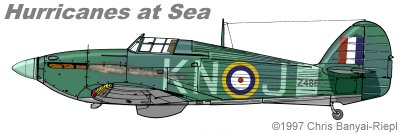

When the Second World War broke out, the RAF had a pair of excellent fighters in the Hurricane and Spitfire, and had plenty of bases to station them at to best utilize their small number. The Fleet Air Arm of the Royal Navy, however, was not so well prepared. In 1937, a crash program was undertaken to provide the Royal Navy with four modern aircraft carriers. By 1938, the Royal Navy had only one of the modern carriers, the HMS Ark Royal, undergoing sea trials. The other carriers were accounted for elsewhere, with the HMS Courageous and HMS Furious in the Home Fleet, the HMS Hermes was in reserve, the HMS Glorious was in the Mediterranean, the HMS Eagle was on the China Station, and the HMS Argus was being used as a training carrier. At the outbreak of war in 1939, the positions of these ships hadn’t changed and the four new carriers, the Victorious, Formidable, Illustrious, and the Indomitable, were a long ways off from being completed. By late 1940, the number of carriers was down by two with the loss of the HMS Courageous and HMS Glorious.
Flying on and off of these ships was a mixture of Blackburn Skuas and Gloster Sea Gladiators, neither of which was a match for the German opposition. In fact, the Ju88 bombers could fly faster than the fighters, making interception nearly impossible. By mid 1940, the Fairey Fulmar began entering service with the FAA, bringing its eight guns to bear against the enemy. Promises from America of Grumman Martlet fighters added to the relief of the FAA, but delivery of these would not be until the end of 1940. This left a gap in the aerial protection of the seas and forced the Admiralty to look elsewhere for solutions.
Hawker Aircraft LTD was approached with the concept of attaching a catapult spool to the successful Hurricane design and make it available to fly at sea. Hawker found that the airframe could handle the stresses of catapult takeoffs, and started converting existing planes to the new Sea Hurricane Mk IA.
Meanwhile, the Admiralty was getting merchant ships ready to handle the new fighters. Called CAM ships, for Catapult Aircraft Merchantmen, these ships were designed to follow the merchant convoys from England to the US, putting them in the path of German aircraft so their fighters could intercept before the enemy could attack. Once the fighters were launched, however, the only recourse at the end of the mission was to either ditch in the sea or fly back to land, as there was no way to get back on the CAM ship. This was as dangerous to the pilot as combat itself, so the RAF flight crews were made up of volunteers.
The first attempt to use Sea Hurricanes to protect convoys started out on May 27, 1941 with the CAM ship SS Michael E. The voyage was uneventful until a U-boat torpedoed the CAM ship and the Sea Hurricane sank to the bottom of the sea along with the SS Michael E. By the end of the first week of July, sixteen CAM ships had sailed and 25 Sea Hurricanes were delivered.
The first Sea Hurricane victory came on August 2, 1941, when Lieutenant R. W. H. Everett slowly intercepted and shot down a Focke Wulf Fw200 Condor. He then proceeded to ditch his Sea Hurricane and was picked up by a destroyer, earning him the DSO. Over the next few weeks the Sea Hurricanes had more encounters with the Fw200 Condor, but no more victories were reported. This was because many of the catapult ships were sunk and the strength and durability of the Fw200. The machineguns of the Sea Hurricane Mk IA were not sufficient to assure a victory over the Fw200.
During the winter months, the Sea Hurricanes did not go to sea due to the adverse weather. Flights did not resume until March of 1942. In the spring of 1942, CAM ships with their Sea Hurricanes were used on convoys to Russia, providing the pilots with more opportunities to intercept German bombers. The deficiency of the CAM ships was made apparent on these convoys. Launching to intercept an enemy raid, the Sea Hurricane might have some good luck and shoot down a bomber or two. After that mission, though, the only solution was to ditch the plane. After that, the Germans could attack without any worries of air interception.
The CAM ships operated up until the summer of 1943. Over the two years they were in use, there were only eight operational launches, which resulted in the downing of six enemy aircraft and the loss of only one pilot. This success ratio clearly shows that the CAM ship principle was sound. It was also a great morale booster for the other merchantmen, looking over and seeing the beautiful shape of a Sea Hurricane poised menacingly on its catapult.